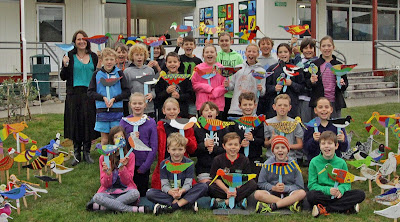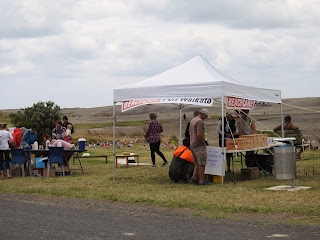THE FLOCK LIVES ON
For us folk in New Zealand this "Year of the Flock"is coming to an end. Many of the migratory birds have already departed on their northern migration.
Our endemic species have completed their breeding seasons. The departed Arctic migrants are being replaced with wrybill and South Island oystercatchers who have themselves moved north for the winter.
As for the Flock of gaily painted wooden birds, well, they are going into hibernation for the winter.
However there has been a last flurry of activity to to mark the departure of the Arctic migrants.
Locally the Port Waikato Flock made an appearance in their sculpture park. Plans are well underway for this Flock to return next Spring, both bigger and brighter than ever.
A little more distant, on Waiheke Island, the Hauraki Classroom packed their birds away as their small flock of godwits departed. They will also reappear next Spring.
There will be some new Flocks next year as various conservation groups have been gifted some "birds"to get them started.
Painted "birds"have been migrating around the country and appearing in many venues. Most recently many of them came to roost in the grounds of the Pukorokoro Miranda Shorebird Centre. BRaid Aid sent a few of their wrybill to overwinter with our birds. Altogether there were 1400 "birds"on display, coming from local schools, Pippins and Brownies, Devonport Peninsula schools, members of the Birds New Zealand Youth Camp, Waiheke Is. and a big contingent from the Bay of Plenty.
Maybe some of the contributors can recognise their "birds"in the following images.
Special mention should be made of this small Flock from the East Asian Australasian Flyway Partnership Secretariat in S. Korea
Of course there were also many other birds on duty in school yards in New Zealand, Australia and S.Korea. The later giving the initiative an international dimension. There are strong indications that other countries will be starting their own Flocks for the next migration season.
LOOKING BACK
The speed at which the Flock initiative gathered its own momentum was a great surprise. It was never a hard sell. For the young and not so young the art work was rewarding in itself but was also a way of demonstrating commitment to the conservation of shorebirds.
That it dovetailed so well with many aspects of the school curriculum was a great help. Learning went alongside the fun activity of painting "birds". We have heard many stories of how students have brought their parents and siblings up to speed on shorebird issues!
The large Flock displays that were to result provided wonderful opportunities to meet the public and talk about shorebirds.
SO MANY PEOPLE DESERVE CREDIT
The impact would have been so much less without the financial support provided by the Living Waters Partnership between DOC and Fonterra. So many people would have had less colour in their lives if Resene had not so generously provided free paint to all of the participants.
Deserving of the greatest praise however are all of the children of NZ, their teachers and support staff, conservation groups and all of the people behind the scenes who supported them. The time that they willingly committed must run into many thousands of hours. The Pukorokoro Miranda Naturalists' Trust would like to thank them for making this initiative such a great success.
THE IMPACT
This was an awareness campaign and just one of many initiatives, local national and international directed toward the conservation of shorebirds and their habitat. We hope that it has contributed to the general ground swell toward conservation of our natural heritage. If it has helped to move the status of shorebirds to the iconic level of our bush birds then it will have been a job well started.
The title of this post is "The Flock Lives" It is true. Next Spring it will be back and not only in the one place and country where it began.
























































